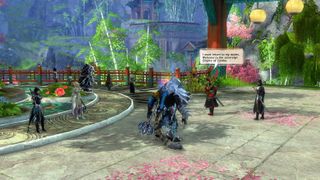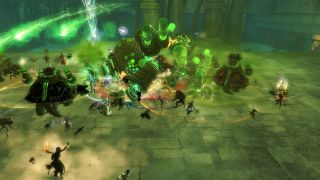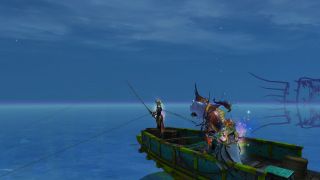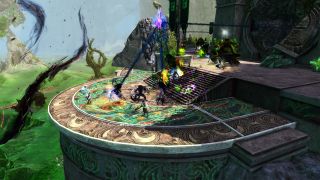PC Gamer is supported by its audience. When you buy through links on our site, we may earn an affiliate commission. Learn more
By published
A worthy send-off to Guild Wars 2’s Elder Dragon saga, and a reason to be optimistic about the future of the game.
A worthy send-off to Guild Wars 2’s Elder Dragon saga, and a reason to be optimistic about the future of the game.
What is it? The third expansion, and the finale to the MMO’s Elder Dragon saga.
Expect to pay $30/£26
Developer ArenaNet
Publisher NCSoft
Reviewed on Ryzen 7 3700X, 32GB RAM, RTX 3080Ti
Multiplayer? Massively
Link Official site
Since the release of End of Dragons, I’ve spent as much time in Guild Wars 2’s older maps as I have in its new Canthan region. It’s a peculiar quirk of the game that a new expansion doesn’t replace what came before. This is an MMO that, in the nine years since its release, has never raised its level cap. The gear and weapons you earned before remain just as relevant today. In that context, End of Dragons doesn’t just need to be good in isolation, but—through its new maps, features and class specialisations—has to weave itself into the larger tapestry of the overall endgame.
Even now, a month after launch, it’s hard to predict what its enduring legacy will be. But one thing is for certain: End of Dragons makes a great first impression.
The campaign is the strongest Guild Wars 2 has delivered yet. In pursuit of a band of sky pirates, the player crashes into the continent of Cantha—triggering a diplomatic incident that results in the region being reopened to the outside world for the first time in hundreds of years. As the vanguard of this new era of trade and tourism, you’re quickly embroiled in the problems of the region.
Broadly I enjoy what ArenaNet has done here. Guild Wars 2’s writing has varied over the years, but tonally it can often feel too arch and sarcastic. Here, instead, it’s breezy—a fun adventure even as the story becomes steadily darker. Its characters are given enough space to work through their feelings as events unfold, but there’s a lightness to the delivery. The conclusion isn’t exactly a surprise—End of Dragons was not a subtle name in a game that has, in recent years, seemed in a hurry to move beyond the Elder Dragons that have dominated up to now. But the route to that point is frequently surprising, and full of memorable moments for both new and returning allies.
It’s more deft in its presentation, too, doing a good job of letting the player revel in both small moments and grand spectacle. It helps that its big, act-ending boss fights are also repurposed for the instanced strike missions. Before End of Dragons, I would struggle to name a campaign boss fight I actually enjoyed. Here, though, there are plenty—likely because their reuse in a more mechanically complex endgame form gives ArenaNet the excuse to spend more time on their construction.
Dragon’s End is the most mechanically complex boss in the open-world. It’s spectacular—both visually and in terms of its challenge and drama.
The maps look consistently beautiful, too. The first, Seitung Province, is bright and vibrant—a spectacular introduction that deftly sets the stage and highlights how the region has changed from its Guild Wars 1 days. The Echovald Wilds, conversely, are dark and foreboding—a twisted forest with dense packs of enemies to convey the threat of the lawless frontier. That said, the ambition at times can’t match Guild Wars 2’s capabilities. New Kaineng City is a grand, towering metropolis that showcases the Jade tech that the region has adopted (and gives ArenaNet an excuse to sidestep the usual tropes of cyberpunk dystopia). It’s impressive to look at, but not as much fun to explore. It’s just slightly too lifeless for a supposedly teeming metropolis, and repeats a consistent issue with the game’s more vertical maps of being annoying to navigate. This is more a problem with the minimap, where the lack of clarity around routes between the different levels of the city can be frustrating—especially during the map-wide meta where quickly navigating between events is a must.
Nonetheless, the new maps are overall a success, and offer a decent degree of challenge too. A good mix of enemy types ensures its fights feel meaningfully different to other regions—Guild Wars 2 has always done a good job of using density, status buffs, debuffs and crowd control effects to make open world encounters feel specific to their map, and that trend continues here. And the map-wide meta events are some of my favourite to date.
Following the template set out by Guild Wars 2’s first expansion, End of Dragons also introduces a new suite of features earned and upgraded through the Masteries XP system. It’s an eclectic collection: fishing, skiffs, a little robot companion, a new mount, and a new hub zone that is home to the expansion’s Strike missions, as well as vendors, services and even a resting XP bonus. Unlike Heart of Thorns and Path of Fire, there’s no one big idea here that’s transformative to the game at large. Gliding and mounts have become so fundamental to Guild Wars 2 that End of Dragons also includes them for players that don’t have previous expansions—because map design would suffer for not having these means of traversal.
With End of Dragons’ own Masteries, though, there’s some nice quality-of-life improvements, but nothing that fundamentally changes my relationship with the game. Fishing is fun, but it’s mostly self-contained, letting you craft food that makes you better at fishing. While it does tie into crafting the new legendary weapons, it’s disappointing that there isn’t a more immediate payoff for the system. Skiffs similarly don’t feel like they have a purpose beyond their own existence when the Skimmer mount already exists. They’re useful for fishing—especially with friends—but that means they are similarly in search of a point beyond a mostly self-contained activity.
Despite its name, End of Dragons isn’t really an end. Nor is it an entirely fresh beginning.
It’s an eclectic tool in an already eclectic feature set, and while that gives it broad utility, it also means it’s not as obviously desirable as one of Path of Fire’s mounts. Still, though, the fact it augments your existing abilities means that—unlike with fishing—the Jade Bot has purpose outside of its own existence. I particularly love the Gliding Booster, because it nicely combos with the existing collection of mid-air mounts and dismount skills in a way that lets you build a lot of height very quickly. It’s perfect for setting up the Griffon’s Aerial Finesse, which lets you speed across maps.
Nevertheless, the Jade Bot system could stand to be less fussy to interact with. The fact that you have to use a Workshop terminal to swap out modules—despite it living on the equipment tab alongside systems that can be altered at will—is just another of the numerous UI quirks that are getting more common as Guild Wars 2 grows older. This is a problem in multiple areas of the game. The best way to actually find the big events and story beats that are out in the open world is still by following the collections that hide within the achievement page, buried inside its nested categories and alongside other, more generic achievements. It’s a system that’s been in need of an overhaul for some time, but one that instead continues to grow—further compounding its own issues.
In this sense, despite its name, End of Dragons isn’t really an end. Nor is it an entirely fresh beginning. It may close out the Elder Dragon saga, but in every other sense it’s a continuation of a game with a long, complicated and sometimes messy history, that nonetheless seems committed to refreshing itself for the future. In an MMO that has only ever become larger and more sprawling—one structured so that new regions only add to the amount of stuff there is to do day-to-day—End of Dragons successfully carves a place for itself alongside nearly a decade’s worth of maps, events and endgame challenges. That the quality of what it adds so often exceeds what came before leaves me hopeful that Guild Wars 2’s best days are still to come.
A worthy send-off to Guild Wars 2’s Elder Dragon saga, and a reason to be optimistic about the future of the game.
Phil has been writing for PC Gamer for nearly a decade, starting out as a freelance writer covering everything from free games to MMOs. He eventually joined full-time as a news writer, before moving to the magazine to review immersive sims, RPGs and Hitman games. Now he leads PC Gamer’s UK team, but still sometimes finds the time to write about his ongoing obsessions with Destiny 2, GTA Online and Apex Legends. When he’s not levelling up battle passes, he’s checking out the latest tactics game or dipping back into Guild Wars 2. He’s largely responsible for the whole Tub Geralt thing, but still isn’t sorry.
Sign up to get the best content of the week, and great gaming deals, as picked by the editors.
Thank you for signing up to PC Gamer. You will receive a verification email shortly.
There was a problem. Please refresh the page and try again.
PC Gamer is part of Future US Inc, an international media group and leading digital publisher. Visit our corporate site.
© Future US, Inc. Full 7th Floor, 130 West 42nd Street, New York, NY 10036.










